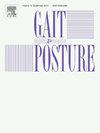Reproducibility and convergent validity of the blazepod stepping reaction test in older people
IF 2.2
3区 医学
Q3 NEUROSCIENCES
引用次数: 0
Abstract
Introduction
Proper balance control requires adaptive stepping, a strategy frequently used to maintain balance at the critical moment of slipping or tripping. Previous studies have confirmed that a slow-stepping reaction is prevalent in older people. Furthermore, those with a slow-stepping reaction are at a higher risk of falling.
Aim
Examine the convergent validity and intra-rater test-retest reproducibility of a novel instrumented stepping reaction test in older adults.
Methods
The study was observational, encompassing a test-retest design. Main outcome measures included the novel instrumented Blazepod Stepping Reaction Test (BSRT), Mini-BESTest including subcategories (Anticipatory, Reactive Postural control, Sensory orientation, Dynamic gait), Timed Up and Go test (TUG), Choice Stepping Reaction Time test (CSRT), Fear of Falling (FoF), and Fall Status Questionnaire.
Results
Fifty older people (33 women, 17 men), with a mean age of 72.2 (SD=4.2), were enrolled in the study. The mean BSRT test score of the study sample was 15.9 (SD=3.2). The intraclass correlation coefficient value for the intra-rater test-retest reproducibility of the BSRT test was 0.793 (95 %CI, 0.493, 0.912). The SEM and MDC values were 1.446 and 2.36, respectively. A moderate-strong correlation score was found between the BSRT and the TUG (r = -0.670). Moderate correlation scores were found between the BSRT and the Min-BESTest total score, anticipatory postural adjustment, and dynamic gait (r∼0.55). Moderate correlations were found between the BSRT, fear of falling (r = 0.40), the CSRT (r = -0.35), and balance sensory orientation (r = 0.37). No associations were found between the BSRT and reactive postural control.
Conclusions
The current study supports the convergent validity and test-retest reproducibility of the BSRT in older people.
求助全文
约1分钟内获得全文
求助全文
来源期刊

Gait & posture
医学-神经科学
CiteScore
4.70
自引率
12.50%
发文量
616
审稿时长
6 months
期刊介绍:
Gait & Posture is a vehicle for the publication of up-to-date basic and clinical research on all aspects of locomotion and balance.
The topics covered include: Techniques for the measurement of gait and posture, and the standardization of results presentation; Studies of normal and pathological gait; Treatment of gait and postural abnormalities; Biomechanical and theoretical approaches to gait and posture; Mathematical models of joint and muscle mechanics; Neurological and musculoskeletal function in gait and posture; The evolution of upright posture and bipedal locomotion; Adaptations of carrying loads, walking on uneven surfaces, climbing stairs etc; spinal biomechanics only if they are directly related to gait and/or posture and are of general interest to our readers; The effect of aging and development on gait and posture; Psychological and cultural aspects of gait; Patient education.
 求助内容:
求助内容: 应助结果提醒方式:
应助结果提醒方式:


